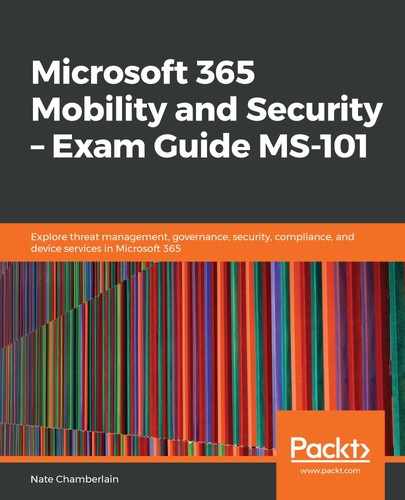Book Description
Get up to speed with planning, deploying, and managing Microsoft Office 365 services and gain the skills you need to pass the MS-101 exam
Key Features
- Explore everything from mobile device management and compliance,through to data governance and auditing
- Get to grips with using Azure advanced threat protection and Azure information protection
- Learn effectively through exam-focused practice exercises and mock tests
Book Description
Exam MS-101: Microsoft 365 Mobility and Security is a part of the Microsoft 365 Certified: Enterprise Administrator Expert certification path designed to help users validate their skills in evaluating, planning, migrating, deploying, and managing Microsoft 365 services. This book will help you implement modern device services, apply Microsoft 365 security and threat management, and manage Microsoft 365 governance and compliance. Written in a succinct way, you'll explore chapter-wise self-assessment questions, exam tips, and mock exams with answers.
You'll start by implementing mobile device management (MDM) and handling device compliance. You'll delve into threat detection and management, learning how to manage security reports and configure Microsoft 365 alerts. Later, you'll discover data loss prevention (DLP) tools to protect data as well as tools for configuring audit logs and policies. The book will also guide you through using Azure Information Protection (AIP) for deploying clients, applying policies, and configuring services and users to enhance data security. Finally, you'll cover best practices for configuring settings across your tenant to ensure compliance and security.
By the end of this book, you'll have learned to work with Microsoft 365 services and covered the concepts and techniques you need to know to pass the MS-101 exam.
What you will learn
- Implement modern device services
- Discover tools for configuring audit logs and policies
- Plan, deploy, and manage Microsoft 365 services such as MDM and DLP
- Get up to speed with configuring eDiscovery settings and features to enhance your organization's ability to mitigate and respond to issues
- Implement Microsoft 365 security and threat management
- Explore best practices for effectively configuring settings
Who this book is for
This book is for IT professionals looking to pass the Microsoft 365 Mobility and Security certification exam. System administrators and network engineers interested in mobility, security, compliance, and supporting technologies will also benefit from this book. Some experience with Microsoft 365, Exchange servers, and PowerShell is necessary.
